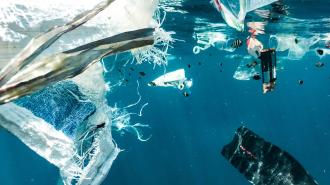Scientists from the University of Texas announced they’ve created a plastic-eating enzyme that could keep billions of pounds of plastic out of landfills.
Now, if that sentence gives you deja vu, you’re not alone.
Followers of science news may have seen similar exciting headlines over the years, from 2008’s Science Fair Project Isolates Plastic-Eating Microbes–about a 17-year-old science fair winner who got bacteria to degrade plastic bags by 43%–to last month’s New Enzyme Discovery is a New Step Towards Beating Plastic Waste, wherein British scientists developed an enzyme that could break down PTA, an ingredient in plastic bottles.
You’ve seen lots of similar titles in between: “New super-enzyme eats plastic bottles six times faster,” “Plastic-eating bacteria could help aid global recycling efforts,” etc., which give the impression of a silver bullet (itself undoubtedly recyclable) that will slay our monstrous plastic problem.
Why are these plastic-eating bacteria just twiddling their thumbs? We’ve got a crisis to deal with!
So what is taking so long? Why are these bacteria just twiddling their thumbs while we have a crisis to deal with?
It turns out there are a few reasons things aren’t so simple:
Plastic isn’t all the same. Many enzymes or bacteria only work for one specific kind of plastic, and much of our trash combines several kinds of plastic.
Most plastic-recycling efforts focus on PET, the plastic used in plastic bottles. PET represents about 20% of global plastic waste. It’s chemically easier to break down than polyethylene or polypropylene, types used in plastic film and food packaging.
That’s an important caveat: most of these solutions would only put a dent in our plastic problem, rather than solve it entirely.
Many solutions only work under special conditions. Often, the reactions or bacteria only work at certain temperatures, in special environments, or after extended periods of time. The harder it is to create the conditions, the less practical it is to do it at scale. This also means that it’s unlikely bacteria will solve the issue of plastic pollution already in nature — more on that soon.
They cost too much. These processes can be expensive. Further, most solutions simply break down plastic to its original monomers, which are really only useful for creating more plastic.
This has two problems: one, it doesn’t reduce the amount of plastic in the world, and two, making new plastic is already really cheap. Creating a costly factory, shipping tons of waste to it, and having bacteria slowly churn out ingredients that are worth virtually nothing — and still aren’t biodegradable — isn’t a great business model or arguably even an efficient use of taxpayer funds.
It’s not necessarily safe or effective to release in nature. Often there’s an assumption that this bacteria could be released to chew through the mountains of plastic we currently have buried in landfills, swirling in the oceans, or scattered as litter.
But even if a bacteria or enzyme could work under totally unregulated conditions, it could have toxic byproducts, destroy plastic that is still in use (like, say, the device you’re using to read this right now, cutting you off from finishing this valuable article), or require releasing tremendous quantities into an area to make a difference.
So, for now, these technologies could really only be used within our existing recycling systems, rather than being a fundamentally new alternative. We will still have to sort, collect, and process all the plastic we want the bacteria to eat.
Fortunately, there’s also some good news: scientists from Japan to Saudi Arabia to the US National Renewable Energy Laboratory are working on these problems, and things are improving.
For example, the recent discovery at UT-Austin identified an enzyme that cuts the time to break down plastic to a matter of hours, and it can work at the relatively attainable temperature of 50 Celsius (122 Fahrenheit). And it was found using an AI algorithm that could continue to iterate and improve its performance.
Fortunately, there’s also some good news: scientists from the US to Saudi Arabia to Japan are working on these problems, and things are improving.
And the first demonstration plant dedicated to enzyme-based plastic recycling recently opened. French firm Carbios, which runs it, announced they have successfully produced new plastic bottles from PET with a process that makes them infinitely recyclable.
That is a breakthrough worth celebrating. Today, even if plastic is recycled (over 80% is not, including over 90% in the US), it can generally only be turned into lower-quality plastic, for niche uses like carpeting.
Traditional mechanical recycling processes are expensive and inefficient, requiring waste to be sorted, shredded, cleaned, melted and pelletized — and discarding any batches contaminated with food or incompatible materials. Chemical recycling processes can often create their own toxic byproducts.
Carbios is planning to create a commercial-scale facility by 2024, and while it doesn’t expect their plastic to be as cheap as freshly made varieties, they hope environmentally-minded companies and consumers will pay a little extra for it. Plus, its approach will allow plastic to be recycled from mixed garbage more efficiently and with less waste.
We don’t have to rely on miracle bacteria to do our dirty work.
Time will tell if new processes will help chip away at our plastic problem.
In the meantime, other scientists and companies are creating biodegradable materials that can replace plastics altogether, from MIT’s cellulose-based solution to companies using bacteria to grow sustainable materials. Governments in Europe are taking another approach and banning harder-to-recycle plastics.
And of course you don’t have to wait for any of them — individuals around the world are finding creative ways to reduce their own plastic use. Exciting as they may be, we don’t have to rely on miracle bacteria to do our dirty work.
We’d love to hear from you! If you have a comment about this article or if you have a tip for a future Freethink story, please email us at [email protected].






